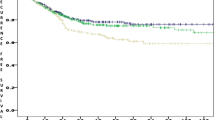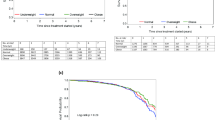Abstract
Purpose
The body mass index (BMI) may be associated with an increased incidence and aggressiveness of urological cancers. In this study, we aimed to evaluate the impact of the BMI on survival in patients with T1G3 non-muscle-invasive bladder cancer (NMIBC).
Methods
A total of 1155 T1G3 NMIBC patients from 13 academic institutions were retrospectively reviewed and patients administered adjuvant intravesical Bacillus Calmette–Guérin (BCG) immunotherapy with maintenance were included. Multivariable Cox regression analysis was performed to identify factors predictive of recurrence and progression.
Results
After re-TURBT, 288 patients (27.53%) showed residual high-grade NMIBC, while 867 (82.89%) were negative. During follow-up, 678 (64.82%) suffered recurrence, and 303 (30%) progression, 150 (14.34%) died of all causes, and 77 (7.36%) died of bladder cancer. At multivariate analysis, tumor size (hazard ratio [HR]:1.3; p = 0.001), and multifocality (HR:1.24; p = 0.004) were significantly associated with recurrence (c-index for the model:55.98). Overweight (HR: 4; p < 0.001) and obesity (HR:5.33 p < 0.001) were significantly associated with an increased risk of recurrence. Addition of the BMI to a model that included standard clinicopathological factors increased the C-index by 9.9. For progression, we found that tumor size (HR:1.63; p < 0.001), multifocality (HR:1.31; p = 0.01) and concomitant CIS (HR: 2.07; p < 0.001) were significant prognostic factors at multivariate analysis (C-index 63.8). Overweight (HR: 2.52; p < 0.001) and obesity (HR: 2.521 p < 0.001) were significantly associated with an increased risk of progression. Addition of the BMI to a model that included standard clinicopathological factors increased the C-index by 1.9.
Conclusions
The BMI could have a relevant role in the clinical management of T1G3 NMIBC, if associated with bladder cancer recurrence and progression. In particular, this anthropometric factor should be taken into account at initial diagnosis and in therapeutic strategy decision making.


Similar content being viewed by others
References
Ng M, Fleming T, Robinson M, Thomson B, Graetz N, Margono C, Mullany EC, Biryukov S, Abbafati C, Abera SF, Abraham JP, Abu-Rmeileh NM, Achoki T, AlBuhairan FS, Alemu ZA, Alfonso R et al (2014) Global, regional, and national prevalence of overweight and obesity in children and adults during 1980–2013: a systematic analysis for the global burden of disease study 2013. Lancet 384(9945):766–781
Colditz GA, Peterson LL (2018) Obesity and Cancer: evidence, Impact, and future directions. Clin Chem 64(1):154–162
Chromecki TF, Cha EK, Fajkovic H, Rink M, Ehdaie B, Svatek RS, Karakiewicz PI, Lotan Y, Tilki D, Bastian PJ, Daneshmand S, Kassouf W, Durand M, Novara G, Fritsche HM, Burger M et al (2013) Obesity is associated with worse oncological outcomes in patients treated with radical cystectomy. BJU Int 111(2):249–255
Choi JB, Lee EJ, Han KD, Hong SH, Ha US (2018) Estimating the impact of body mass index on bladder cancer risk: stratification by smoking status. Sci Rep 8(1):947
Zhao L, Tian X, Duan X, Ye Y, Sun M, Huang J (2017) Association of body mass index with bladder cancer risk: a dose-response meta-analysis of prospective cohort studies. Oncotarget 8(20):33990–34000
Kwon T, Jeong IG, You D, Han KS, Hong S, Hong B, Hong JH, Ahn H, Kim CS (2014) Obesity and prognosis in muscle-invasive bladder cancer: the continuing controversy. Int J Urol 21(11):1106–1112
Babjuk M, Oosterlinck W, Sylvester R, Kaasinen E, Bohle A, Palou-Redorta J, Roupret M, European Association of Urology (2011) EAU guidelines on non-muscle-invasive urothelial carcinoma of the bladder, the 2011 update. Eur Urol 59(6):997–1008
Kluth LA, Xylinas E, Crivelli JJ, Passoni N, Comploj E, Pycha A, Chrystal J, Sun M, Karakiewicz PI, Gontero P, Lotan Y, Chun FK, Fisch M, Scherr DS, Shariat SF (2013) Obesity is associated with worse outcomes in patients with T1 high grade urothelial carcinoma of the bladder. J Urol 190(2):480–486
Hendricksen K, Aziz A, Bes P, Chun FK, Dobruch J, Kluth LA, Gontero P, Necchi A, Noon AP, van Rhijn BWG, Rink M, Roghmann F, Roupret M, Seiler R, Shariat SF, Qvick B et al (2017) Discrepancy between European association of urology guidelines and daily practice in the management of non-muscle-invasive bladder cancer: results of a European survey. Eur Urol Focus. https://doi.org/10.1016/j.euf.2017.09.002
Babjuk M, Bohle A, Burger M, Capoun O, Cohen D, Comperat EM, Hernandez V, Kaasinen E, Palou J, Roupret M, van Rhijn BW, Shariat SF, Soukup V, Sylvester RJ, Zigeuner R (2017) EAU guidelines on non-muscle-invasive urothelial carcinoma of the bladder: update 2016. Eur Urol 71(3):447–461
Flegal KM, Carroll MD, Ogden CL, Curtin LR (2010) Prevalence and trends in obesity among US adults, 1999–2008. JAMA 303:235–241. https://doi.org/10.1001/jama.2009.2014
Kamat AM, Sylvester RJ, Bohle A, Palou J, Lamm DL, Brausi M, Soloway M, Persad R, Buckley R, Colombel M, Witjes JA (2016) Definitions, end points, and clinical trial designs for non-muscle-invasive bladder cancer: recommendations from the international bladder cancer group. J Clin Oncol 34(16):1935–1944
Chu KF, Rotker K, Ellsworth P (2013) The impact of obesity on benign and malignant urologic conditions. Postgrad Med 125(4):53–69
Cohen DH, LeRoith D (2012) Obesity, type 2 diabetes, and cancer: the insulin and IGF connection. Endocr Relat Cancer 19(5):F27–F45
Qin Q, Xu X, Wang X, Zheng XY (2013) Obesity and risk of bladder cancer: a meta-analysis of cohort studies. Asian Pac J Cancer Prev 14(5):3117–3121
Ma Y, Yang Y, Wang F, Zhang P, Shi C, Zou Y, Qin H (2013) Obesity and risk of colorectal cancer: a systematic review of prospective studies. PLoS One 8(1):e53916
Olsen CM, Nagle CM, Whiteman DC, Ness R, Pearce CL, Pike MC, Rossing MA, Terry KL, Wu AH, Australian Cancer S, Australian Ovarian Cancer Study G, Risch HA, Yu H, Doherty JA, Chang-Claude J, Hein R et al (2013) Obesity and risk of ovarian cancer subtypes: evidence from the ovarian cancer association consortium. Endocr Relat Cancer 20(2):251–262
Yang Y, Dong J, Sun K, Zhao L, Zhao F, Wang L, Jiao Y (2013) Obesity and incidence of lung cancer: a meta-analysis. Int J Cancer 132(5):1162–1169
Borges M, Franca E, Fujimori M, Silva S, Marchi P, Deluque A, Honorio-Franca AC, Abreu L (2018) Imbalance between adipokines and cytokines can promote obesity-related disorders. Endocr Metab Immune Disord Drug Targets 18(3):260–267. https://doi.org/10.2174/1871530318666180131094733 (E-pub Ahead of Print)
Hilmy M, Campbell R, Bartlett JM, McNicol AM, Underwood MA, McMillan DC (2006) The relationship between the systemic inflammatory response, tumour proliferative activity, T-lymphocytic infiltration and COX-2 expression and survival in patients with transitional cell carcinoma of the urinary bladder. Br J Cancer 95(9):1234–1238
Cantiello F, Cicione A, Salonia A, Autorino R, De Nunzio C, Briganti A, Gandaglia G, Dell’Oglio P, Capogrosso P, Damiano R (2015) Association between metabolic syndrome, obesity, diabetes mellitus and oncological outcomes of bladder cancer: a systematic review. Int J Urol 22(1):22–32
Calle EE, Rodriguez C, Walker-Thurmond K, Thun MJ (2003) Overweight, obesity, and mortality from cancer in a prospectively studied cohort of US adults. N Engl J Med 348(17):1625–1638
Batty GD, Shipley MJ, Jarrett RJ, Breeze E, Marmot MG, Smith GD (2005) Obesity and overweight in relation to organ-specific cancer mortality in London (UK): findings from the original Whitehall study. Int J Obes 29(10):1267–1274
Wyszynski A, Tanyos SA, Rees JR, Marsit CJ, Kelsey KT, Schned AR, Pendleton EM, Celaya MO, Zens MS, Karagas MR, Andrew AS (2014) Body mass and smoking are modifiable risk factors for recurrent bladder cancer. Cancer 120(3):408–414
Xu T, Zhu Z, Wang X, Xia L, Zhang X, Zhong S, Sun F, Zhu Y, Shen Z (2015) Impact of body mass on recurrence and progression in Chinese patients with Ta, T1 urothelial bladder cancer. Int Urol Nephrol 47(7):1135–1141
Aknowledgements
M.D.V is supported by the Scholarship Foundation of the Republic of Austria—OeAD and by the EUSP Scholarship—European Association of Urology.
Author information
Authors and Affiliations
Contributions
MF, MDV, GIR, ARAF, VM, GL: protocol/project development. All authors: data collection or management. All authors: data analysis. MF,GIR, MDV, FC, GL: manuscript writing/editing
Corresponding author
Ethics declarations
conflict of interest
The authors declare that they have no conflict of interest, nothing to declare.
Research involving human participants and/or animals
This is a retrospective study. Institutional review board approval was granted by means of a general waiver for studies with retrospective data analysis in each center. All procedures performed were in accordance with the ethical standards of the institutional and/or national research committee and with the 1964 Helsinki declaration and its later amendments or comparable ethical standards.
Informed consent
Written informed consent to take part was given by all participants.
Additional information
Giuseppe Lucarelli and Vincenzo Mirone shared senior authorship.
Rights and permissions
About this article
Cite this article
Ferro, M., Vartolomei, M.D., Russo, G.I. et al. An increased body mass index is associated with a worse prognosis in patients administered BCG immunotherapy for T1 bladder cancer. World J Urol 37, 507–514 (2019). https://doi.org/10.1007/s00345-018-2397-1
Received:
Accepted:
Published:
Issue Date:
DOI: https://doi.org/10.1007/s00345-018-2397-1




